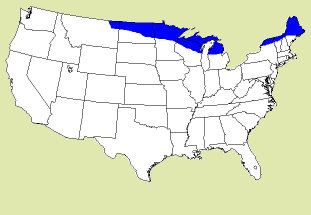Descriptive Qualities:
Range
The Columbian moth's range is upper Michigan, Wisconsin, parts of upper New York, Vermont, New Hampshire and Maine.
Map of this moth's Area:

Eggs and Larva
Depending on the particular size of the moth, approximately 150 - 250 eggs. When Columbian larva first hatch, they are black. For second instar and third, the larva are green. Fourth and Fifth instar larva looks much like a Cecropia caterpillar.
Scenting and Mating
The following information is unknown to me as I have not raised them yet, I will post the information as soon as it becomes available!
Cocoons
Personal Markings or Characteristics
The Columbian moth looks somewhat like a Cecropia. It has the same white cresents on it's wings. However, it is much smaller than Cecropia moths. It also lacks the red in it's wings that Cecropias have.
Caring For Columbian Moths, In All Stages:
Here are some notes that may be helpful when trying to raise Columbian larva, especially if it's your first time raising them.Caring for the eggs
To care for Columbian eggs, just put them in a small container. It is best to be small, because the larva like to crawl a lot when they first hatch, and if you put them in a bigger container, they will crawl away from the food you put in with them, and might not be able to get back. That's a lot of area for such a small caterpillar.
Food Plants
Here is a list of all food plants that I have ever used to raise Columbians on. In the odd occurance that you can not come by any of these, you should contact me.
Raising Columbian Larva (Inside)
The following information is unknown to me as I have not raised them yet, I will post the information as soon as it becomes available!
Raising Columbian Larva (Outside)
The following information is unknown to me as I have not raised them yet, I will post the information as soon as it becomes available!
I only had Columbians for a few weeks, but after talking to some other people, and describing how they died. I have come to the conclusion that it was from lack of air flow. Air flow is very neccessary for all Hyalophora species. Make sure you take this into account if you plan to raise them. Do not try to raise them without a container that will give them maximum airflow, they will die!
Caring for the cocoons
Caring for Columbian cocoons is pretty simple. You should put them in an area where it is fairly moist, if the cocoons dry out, they will die. If you just put them outside they should be fine. You cannot leave them inside, because they will hatch, but you can keep them in the refridgerator. If you do this, it is best to spray the cocoons with a light mist every once in a while so they don't dry out.
Click here to return to the Index
Comments and suggestions are welcome, send them to me at: [email protected]